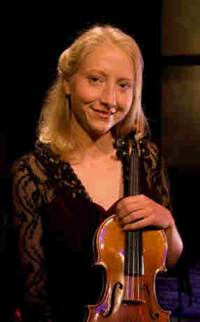
 |
 |
|
Date and Venue February 5, 2020 at 7:30pm | Knox United Church, 5600 Balaclava St., Vancouver One-keyed Flute Jeffrey Cohan Violin Carrie Krause Viola Victoria Gunn, Cello Caroline Nicolas Reviewer Elizabeth Paterson |
||||||||||||||||||||||||||||||||||
|
The four flute quartets are not considered to be amongst Mozartís best work, but each one expresses Mozartís grace and distinctive sparkle and the depth which a great composer can give to even a light work. Add the undulating warmth of baroque instruments and a quartet's give and take for an evening of charming Mozart, delightfully played. Salish Sea Early Music Festival (SSEMF) chose to play the three shorter quartets in chronological order, or at least as the chronology is currently established, it having been a disputed issue over the years. The quartets were commissioned apparently by a business man who had made a quite lot of money and wanted some short, not-too-difficult pieces. Mozart engaged for 2 Concertos and 4 quartets. Whether he actually fulfilled his contract is perhaps moot. Two of the quartets have only two movements and there is quite a lot of ambitious writing for the flute. Perhaps Ferdinand de Jean was not quite as hopeless as he is made out to be At any rate, there is no doubt about the degree of accomplishment of all the four players in this performance. Jeffrey Cohan, founder and artistic director, is well-known in Vancouver as a virtuoso performer. His skill made everything seem easy and light as air and there was excellent rapport amongst the players. Carrie Krause (violin) paired with the flute as seamlessly as if she were playing in a string quartet with another violin. Victoria Gunnís (viola) playing was impeccable and lively, Resonant, vivacious cello playing from Caroline Nicolas grounded and enriched the harmonies and counterpoint, and engaged in animated eloquence when taking a leading role. The Quartet in C major drew honeyed tones from the strings and sweetness from the flute in the charming and sprightly Allegro. A typical Theme and Variations followed, featuring an elegant, dancey Theme and Variations highlighting each instrument. The fourth variation over an ostinato figure was particularly effective. The Quartett in G major, rich and smooth as chocolate, maintained the elegant, measured pace established in the opening piece, and displayed delightful a conversational involvement. The third quartet, Quartett in A major, opened as the G major closed with Theme and Variations. Again Mozartís effortless instrumental conversations were at work with the four players seemingly chatting amongst themselves with wit and good humour. A captivating Menuetto was followed by a Rondeau deftly played with obvious enjoyment by all. The Quartett in D major made up the whole of the second half of the programme. Possibly the earliest piece of the four, it is also the most expansive with its classic three movement structure and fluid, running lines for the flute in the Allegro. The second movement is an Adagio. Long, expressive lines for the flute are accompanied by plucked strings. Cohanís ornaments were finely observed, interesting and never obtrusive. Although only a few minutes in length, it held a rare depth of feeling. A good humoured Rondo finished the evening in high style. SSEMF will return next month for a journey with Dr. Burney. Expect exciting travels. © 2020 Elizabeth Paterson |
||||||||||||||||||||||||||||||||||||
|
|
||||||||||||||||||||||||||||||||||||
|
|
||||||||||||||||||||||||||||||||||||